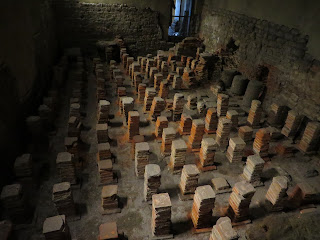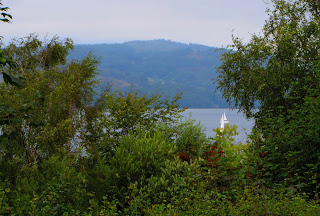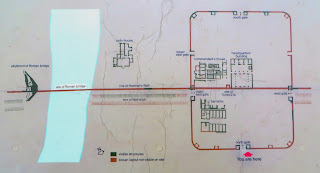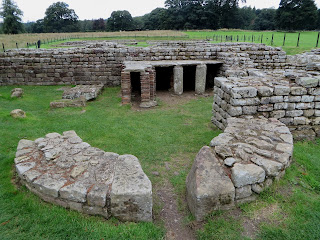On this side of the Atlantic, if a guy "knocks up" a gal, Dad's not going to come after him with a shotgun. At a friendly tennis tournament I played in to correspond with the U.S. Open Tennis Championships, the participants were invited to "knock up" (warm up) before starting regular play. Perhaps wanting an advance excuse for possible poor play during the tournament, one of the fellows announced that he felt "manky" (shaky). And, after each mini-match of the tournament, we moved "anti-clockwise" around the courts.
As Henry and I drove north to Edinburgh (more on that outing later), we were reminded that the Brits travel on "motorways" and "carriageways" rather than highways, turnpikes, and interstates. We also encountered "urban clearway" signs, which we were told means no stopping. When exiting the carriageway or motorway, we were sometimes directed to the "verge" or soft shoulder. For those of you familiar with I-5N near the San Clemente Border Patrol checkpoint, you have seen yellow triangle signs with black silhouettes urging awareness of families running across the interstate. In Britain, the blacks silhouettes are of a hunched over couple, with cane in hand, urging caution for the elderly. Okay, the Brits do have other caution signs, such as for sheep grazing by the roadside.
On the culinary front, I now know that fried chicken "goujons" are the American equivalent of chicken fingers, but the Brits also offer other types of "goujons", or strips, such as fish. When I first saw some British menu items described as "homely", I thought it was a typo for "homey". After seeing this "mistake" repeated on a number of menus, I decided that cottage pie, fish and chips, and pork belly are indeed the simple, unpretentious, "Homely Classics".
Perhaps the following are "you had to have been there moments", but I'll nevertheless try reporting them:
Picture a youngish woman out for a run with her dog. Admittedly, that's nothing out of the ordinary. Next, imagine the dog on a leash, running ahead of the woman--again, nothing odd about that. However, now, visualize the leash being attached to a harness around the woman's shoulders, chest, and mid-section. Not exactly your normal run in the park! Sorry to have missed the photo op!
Here's a cute story for those of you into cuteness: During our visit to Kenilworth Castle, Henry overheard a boy of about 5 years of age shout to his father, "I have to go to the loo!" Dad points the way. As the boy is trotting ahead of Dad, he encounters a man and a woman costumed in 16th or 17th formal dress. The boy stops in his tracks, dumbfounded, and yells, "Daddy, it's the queen!"
Finally, check out a photo that definitely offers much more than a verbal description--Henry and I stopped for lunch at a lovely pub, Church Green in Lymm, on our way to the Lake District. A proper gent, wearing a starched white Oxford shirt, bow tie, and suit jacket, was lunching with a very casually dressed friend at a nearby table. The gent had a unique way of protecting himself from possibly wayward splashing food:
The Baths of Bath
While one of Henry's graduate students from UCSD was here, I was able to take advantage of car service to Bath and Warwick. I got dropped off to do my thing, while Henry and his student continued on for meetings with various scientist colleagues. They finished their business at the University of Bath too quickly for me to get much beyond the Roman Baths and Bath Abbey, but I nevertheless had a fine time.
In fact, the ancient Roman Baths were covered with an ingenious roof. By effectively creating hollow bricks for the roof and setting raised floors, the Romans were able to have heat circulating throughout the baths. The hollow bricks for the roof also made them lighter, which allowed their use over the roof expanse.

Another piece of Roman ingenuity was the use of pipes to carry water from the hot springs to the reservoir to the bath itself. Never mind that the pipes were made of lead, which the Romans also used to line the bottom of the bath, and which we now know is bad for human ingestion. The pipes themselves were neatly housed below the floor, just as pipes today are often hidden behind walls.
Parts of the baths which continued in use over the millennia, such as the reservoir, stand in their altered condition.
Other parts of the ancient Roman baths, which lay hidden for some many years, are displayed as they were found.
Additional pieces are well displayed in the museum area.
And, as you can see from this quotation from the 1st century, some things never change!
Bath Abbey and Surrounding Area

As does Stratford-upon-Avon (duh), of Shakespeare renown, both Bath (here) and Warwick (just below) are likewise on the Avon.
Warwick--The Castle, Lord Leycester Hospital, and Mill Garden
I knew going in that Warwick Castle is owned by the Tussauds Group of wax statue fame and is heavily geared to families. Nevertheless, with two Michelin stars ("Recommended") and the Michelin Green Guide describing it as "Britain's finest medieval castle", how could I take a pass on the place? The 50% off the otherwise exorbitant entrance ticket fee, which I received through my English Heritage pass, softened the blow to the pocket book. Yes, there were special hyped-up attractions for the kids, for which I forewent the additional fee, and wax figures peppered the exhibit areas, but I still enjoyed the visit, especially having recently read "The Kingmaker's Daughter", one of the Cousins' War (War of the Roses) books by Philippa Gregory. Warwick Castle figured prominently in the book, as it dealt with Richard Neville, Earl of Warwick (aka The Kingmaker), and his various machinations to control who wore the English crown during the mid-1400's.
Among my favorite parts of the castle visit were the walk along the parapets:
and views from the towers:
The jousting session was rather hokey,

but the trebuchet demonstration was interesting, as we watched the human "squirrels" running along inside a large wheel to "wind up" the "sling" into ready mode before releasing the sling and sending the heavy artillery a couple of hundred meters along the fairway. Back in the day when castles were under siege, trebuchets were used to hurl heavy objects at the castle walls in hopes of breaking them down. To be sure, the guidance systems on these trebuchets could not have been particularly accurate!
I happened upon a castle employee presenting an amusing talk about an armor display, and enjoyed his use of a handy tablet to show off photos of helmets that were not part of the exhibit, but added more visuals to his discussion of ceremonial versus combat armor and the extremes to which knights and nobles would go in armor and helmet designs in furtherance of their individual vanity.
Lord Leycester Hospital
These buildings probably date from the early 1400's. In 1571, Robert Dudley, the 1st Earl of Leicester who is known for wooing Queen Elizabeth I at Kenilworth Castle (see Musings in the Midlands), obtained this property and established a retirement home for old soldiers disabled in the service of the Queen. It was never used as a "hospital", and to this day, it remains a retirement home for former service members.
The small military museum housed in the Guildhall saddened me more than inspired me, as I viewed a far too long list of wars, battles, and other military operations in which the proud 3rd and 7th Hussars gave their lives.
The Town and Gardens of Warwick
The Lake District
Henry and I took advantage of Judi and Bernie's (my sister and brother-in-law) travel to Ireland and Scotland to take a road trip through the Lake District on our way to meet up with them in Edinburgh. My only regret about the drive was that we weren't able to spend more time in that magnificent area of the country.
Lake Windermere (10 miles long; longest lake in England)
Grasmere Lake
Henry drove admirably on the windy, narrow roads that were often bordered on both sides with rock "fences".
The off and on rain showers the entire time we were there did nothing to dampen our enjoyment of the lakes, the rolling hills, the walks, or the boat ride on Ullswater Lake:
We stayed two nights in Ambleside, on the northern tip of Lake Windermere.
The town is filled with guest houses (including the pleasant one at which we stayed (see photo above)), appearingly a result of residents converting their homes to accommodate the numerous tourists that swarm to the area, especially in the summer. Even on a rainy weekend at the end of August, there were few rooms to be had.
We failed in our overly ambitious plan to make stops and still drive all the way west to the ocean with only one full day in the Lake District. We made it as far west as Keswick on Lake Derwentwater, which is pretty much in the middle of the District. Like Ambleside, it attracts and accommodates many tourists. While Henry had his double espresso with a twist of lemon peel, his dose of mathematics equations on paper napkins, and his doze, I got to peek at the lake:
and stroll through the market:
Henry and I are already talking about returning to the Lake District for a longer stay, independent of this sabbatical. We would likely locate in a smaller, less touristed town, such as Grasmere. And, as long as I get to take walks like the one I took along Aira Beck (or brook) to the waterfall of Aira Force (from "fors", the Viking word for waterfall) and its environs, I'll be a happy camper. Here's a sampler--rain did not deter me!
Our Lake District experience also provided us with a few more words of British vocabulary, which, if you do crossword puzzles or your name is Bob P., are not necessarily new to you. A "tarn" is a small mountain lake, or as Henry says, a lakelet; a "fell" is a mountain, which is all relative to whether you are in England or the Himalayas, or even the Adirondacks, for that matter; and a "how" is a low hill. But wait, there's also "knott" (a craggy hill), "pike" (a sharp-pointed hill), and "band" (the ridge of a hill)! I'm not sure if there is a British term for the rock walls bordering the road and apparently separating land parcels, but their appearance is far more prevalent in this area of the country than farther south, in the Midlands. Sheep fill the countryside more or less all over the country (I was warned by my friend, Benay, to expect to see more sheep than people, and especially around the Lake District and Scotland, that is spot on), but in some areas, the Enclosure Movement of the 18th and early 19th centuries seems to have taken hold more than in others, where sheep tend to graze in the community "commons". We don't know what to make of the sheep grazing on the moors (open, uncultivated upland), through which we drove on our way back from Edinburgh. Especially in North York Moors National Park, the sheep hold sway over the roads as well as the fields. One evening, on our way to a pub somewhere in the North York Moors, a sheep was literally sitting in the middle of the road, oblivious to any moving vehicles! A few sheepish friends weren't quite as bold, as they milled around just off both sides of the narrow, curbless (and no stone walls) road.
Edinburgh, St. Andrews, and Environs
With superlative driving by Henry and adequate navigating by me, we arrived in Edinburgh with enough time for me to visit Edinburgh Castle and for Henry to get his post-drive nap before meeting Judi, Bernie, Kris and Tom (Judi and Bernie's friends and travel companions) for dinner. The castle sits atop a hill overlooking the rest of the city.
Considering how cold and windy it was on the walk up to the castle,
I knew it would be blisteringly blustery walking within and looking over the castle walls. To say, yes, it was, is an understatement! With intermittent rain adding to my difficulties, I was hard-pressed to hold my relatively lightweight camera steady with two hands, though I still had to hold my umbrella erect as well, with one one of them! Parts of the castle remain from the 12th century, specifically St. Margaret's Chapel, but most of the buildings date from a few centuries later.
Several military museums are housed within the castle walls, as well as a war memorial to Scots who died in World War I (and later to Scots who gave their lives in World War II and other military encounters),
an exhibit of what prison life was like in the castle
(prisoners earned their keep by using their handiwork skills),
and the crown jewels of Scotland. There's quite a build up to the jewels, probably to deal with large crowds on warm days during the summer. I was able to march through the historical montages and spend as much time as I desired viewing the jewels (sorry, no photographs of the jewels permitted). Despite the formal unification of Scotland with England in the early 1700's (mostly for defense reasons from the English perspective; mostly for economic reasons from the Scottish perspective), the Scottish crown jewels (crown, scepter, and sword), as well as the "stone of destiny" (it's really a stone!), remain important symbols of Scottish honor.
I still haven't figured out the difference between hussars and dragoons (I think they are both historically cavalry), but I enjoyed their tartan attire and accoutrements.
The snuff mulls
definitely matched their outfits better than the powder horns!
As with all castles I have seen so far, Edinburgh Castle had its Great Hall. To my knowledge, this configuration of a dozen pistols on one end of the Great Hall did not operate as a clock!
All in all, the highlights of my castle visit were the wonderful panoramic views of the city:
Looking back toward the castle was rather impressive as well:
For all the chill, rain, and wind we had in Edinburgh, we lucked out with a magnificent day riding to St. Andrews with Judi, Bernie, Kris, and Tom and a local guide. After taking in the streets of old Edinburgh the day before,
(check out the red telephone booth, which is amazingly still prevalent throughout Britain)
(I love the name of this pub (The Filling Station)! It reminds me of Henry's report of a sign above a urinal at Oxford's Pub in Chicago: "At Oxford's, you don't buy beer, you just rent it.")
the views during our drive gave us an additional flavor of Edinburgh and the environs:
(I don't recall ever seeing a flock of only black sheep before!)
We rode through some quaint villages--
Falkland:
Anstruther:
(Judi and Bernie)
 (Not my car)
(Not my car)Elie:
and had lunch at Jigger Inn, THE golfers' place to be in St. Andrews (unless it's on one of the seaside courses).
I cannot recommend the food, but the company was nice!
and its university:
but, for me, the big highlight was St. Andrews Cathedral, originally built in the 12th century, and the largest church ever built in Scotland. After the Reformation, many of the stones from the cathedral were quarried for other edifices, so much of the location is ruins. Nevertheless, it is easy to get a sense of its past grandeur from the massive enclosure and the remaining outlines of the buildings.
Also, St. Rule's Tower (right side of the above photo), with its 151 steps, provided wonderful views, not only of the cathedral remains below, but of the North Sea, St. Andrews, and surrounding countryside.
To top off the lovely day, we got to celebrate Judi's birthday with her at one of the best restaurants we have visited since we arrived in the UK (Ondine, in Edinburgh). Happy Birthday, Judi!
And, thank you Kris for shlepping the candelabra all the way from Colorado!
Aside from our close encounter with sheep roaming around on a desolate road in the North York Moors and seeing stars in the sky for the first time since the beginning of this sabbatical, the highlight of our drive back from Scotland was a visit to a couple of spots along Hadrian's Wall. The wall was originally built in the 2nd century on the order of Roman Emperor Hadrian and was intended as a defense of the northern boundary of the Roman Empire. It extended 73 miles, but is now only sporadically visible. The best places to get a sense of the wall are at the remains of forts, military compounds, and storehouses along the way. English Heritage has done an excellent job of maintaining a number of these sites, and our nifty annual passes prompted even Henry to wander through the ruins! We stopped first at Chesters Roman Fort and Museum.
Chesters was one of the earliest forts built along the wall, and regiments from various parts of the Empire were stationed there until the Romans pulled their troops in the early 5th century. Although little remains of the fort above what is now ground level, outlines of the barracks, Commandant's house, gates, bath house, and bridge abutment where the "wall" crossed the Rive Tyne are all visible.
The bath house sat close by the river.
Not only did this provide easy access to water for the cold bath and hot bath, it permitted easy drainage from the latrine.
The museum at Chesters contained a solid collection of items found during the excavation of the fort and immediate area. Among the most interesting was a shoe, in amazingly good condition!
We also stopped at Corbridge Roman Town, which technically was not located at Hadrian's Wall, but stood nearby, and was originally a supply base for the Roman army.

From the visible outline of the town's buildings, one can also see how "Main Street" was the focal center.
The granaries were particularly impressive in their construction. The floors were built above channels and vents to the outer walls. This allowed the air below to circulate and thus prevent the grain from getting moldy.
As at Chesters, this site had a small, but impressive museum. Among its contents are this lion and stag statue, which was found during excavations of the site.
North York Moors
We had a quick view of the moors when we drove to dinner at the Lion Inn (excellent food and pear cider!), which appeared to be in the middle of nowhere, but in fact was the middle of the North York Moors!































































































































































No comments:
Post a Comment